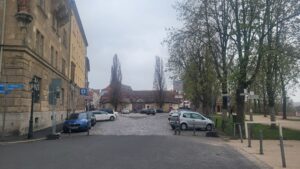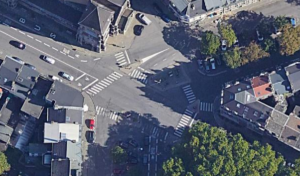The Importance of Crosswalks
To set the scene: my friend and I get off the train in Aschaffenburg – a small city in Bavaria. As we attempted to navigate our way from the station to our hotel, we came across a minor issue: several of the major streets lacked crosswalks. It wasn’t that the crosswalks were out of the way, or in inconvenient locations: there was no crosswalk on the road we needed to cross. Closer to our hotel, there was a single underpass for a very long stretch of the road, forcing the choice between a blind crossing of a busy road or back tracking a significant distance. This was made worse by the lack of adequate lighting.
While this experience was annoying, it should not have been surprising. American municipalities often have similar areas. After all, while I live in a fairly walkable neighborhood, I’m not particularly far from areas that aren’t. Aschaffenburg is much smaller than my hometown – in 2015, my hometown had approximately 150,000 people to Aschaffenburg’s 67,000 people.

More surprisingly was the experience trying to get to our hotel in Liege, a major city in the French-speaking part of Belgium, a few weeks later. However miserable the walk in Aschaffenburg was, the walk in Liege was worse. In order to reach our hotel, we had to cross through a star-shaped intersection. While oddly-shaped intersections can be useful, they need to take into account how pedestrians will move through the intersection. While there were several islands to help pedestrians, and crosswalks between the islands, several of the smaller streets had no direct crosswalks. This made the entire situation far more dangerous for pedestrians than necessary. Liege is larger than my hometown, with 180,000 people in 2015. Unlike my hometown, which is often described as a suburb, Liege is a major city. Liege’s population density is far greater than my hometowns. That intersection wasn’t in the middle of nowhere – it was minutes from the Meuse river and other key sections of downtown. One of the buildings just beside the intersection was a church – an area that pedestrians need to be able to easily access. While Liege is an old city, which limits how they can alter their road plans, that does not excuse putting pedestrians at risk.

Even beyond the difference in continent, there are other reasons to expect better pedestrian safety in Aschaffenburg and Liege. Both Aschaffenburg and Liege are far older than my town could imagine – with the earliest version of my hometown being founded in the 1800s. Aschaffenburg was initially a Roman settlement and people have been living in Liege since even earlier than that. Expecting old cities to be more pedestrian friendly is not ridiculous – for the vast majority of their histories the primary mode of transportation was walking. The fact that both of these cities have managed to develop car-centric infrastructure in a manner that prevents pedestrians from exploring their surroundings is a tragedy. Bonn has its issues, but is somehow significantly more walkable than either of these two cities.
Au revoir!
Carden
Looking Back . Town of Cary. (n.d.). https://www.carync.gov/recreation-enjoyment/about-cary/looking-back
Encyclopædia Britannica, inc. (n.d.). Liège. Encyclopædia Britannica. https://www.britannica.com/place/Liege-Belgium
Encyclopædia Britannica, inc. (n.d.-a). Aschaffenburg. Encyclopædia Britannica. https://www.britannica.com/place/Aschaffenburg
Aschaffenburg – Population Trends and Demographics. City-facts. (n.d.). https://www.city-facts.com/aschaffenburg/population
Liège – Population Trends and Demographics. City-facts. (n.d.-b). https://www.city-facts.com/li%C3%A8ge/population
Cary – Population Trends and Demographics. City-facts. (n.d.-b). https://www.city-facts.com/cary-north-carolina/population
